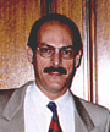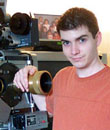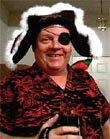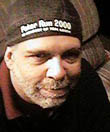|
|
This topic comprises 2 pages: 1 2
|
|
Author
|
Topic: Happy Birthday George Eastman
|
|
|
John Pytlak
Film God

Posts: 9987
From: Rochester, NY 14650-1922
Registered: Jan 2000
|
 posted 07-13-2004 12:32 PM
posted 07-13-2004 12:32 PM





Yes --- there was a celebration at the International Museum of Photography at the George Eastman House:

George Eastman

George Eastman and Thomas Edison with Movie Camera and Film
http://www.democratandchronicle.com/biznews/0713OA4SP3H_business.shtml
quote:
Honoring Eastman
Family, area leaders mark the icon's 150th birthday
By Tyra Hughley
Staff writer
Eastman Kodak Co. Chairman and CEO Dan Carp on Monday extols the legacy of George Eastman during the 150th birthday celebration of the industrial giant and philanthropist at the Dryden Theatre.
(July 13, 2004) — George Eastman's life and his many contributions to Rochester and the world were celebrated Monday in ceremonies marking the legendary philanthropist's 150th birthday.
Several hundred people, including a Who's Who of local dignitaries, gathered for the ceremonies at the Dryden Theatre on East Avenue, on the grounds of what had been Eastman's home. The house now serves as a museum of his greatest contribution — the development of modern photography and film.
“The legacy of his presence continues to influence the country and the world,” said Eastman Kodak Chairman and Chief Executive Daniel Carp, one of several speakers. Rochester is not the only place celebrating Eastman's birthday, Carp said, noting that events are planned in England, Japan and Russia.
The trademark slogan Eastman chose for his company, ‘You press the button, we do the rest,' captured the essence of his goals, both personally and professionally, Carp said. He said Kodak's values — respect, integrity, trust, credibility, continued improvement, and recognition and celebration — were established in Eastman's spirit.
“These values are as true today as they were when Kodak first opened,” Carp said. “Eastman wanted to make picture-taking as simple as using a pencil. Now, he has made photography accessible to people around the globe.”
Although Eastman may be best known for the company that bears his name, he is also celebrated for the many institutions he established with his gifts.
“George Eastman set a standard of community support that continues to guide those of us who are the custodians of his legacy,” Carp said.
Some of the beneficiaries of Eastman's benevolence include the University of Rochester, Rochester Institute of Technology, Howard University in Washington, D.C., and Harvard University in Cambridge, Mass. He also established the United Way of Rochester and created dental centers here and abroad.
Eight of Eastman's descendants were at the gathering.
Dr. Patricia Jones Blessman, of Chicago, a distant relative by marriage, said that Eastman was also a cultural innovator.
“Both his mother and father were abolitionists, and in the 1930s he was hiring black managers in a time where Jim Crow was rampant throughout the nation,” said Blessman, an African American. “He believed that color prejudice was a hindrance to the business community.”
Carolyn Pontes, 26, of Marrianna, Fla., said this is her first visit to Eastman's hometown. He was her distant uncle.
“I am really just amazed at the impact he had on the community,” Pontes said. “When I was growing up, I didn't really know too much about him except that he had something to do with Kodak. But when I got older, I learned of his significance. I will definitely pass his legacy on when I have kids and they are at an age when they are able to understand.”
Monday's ceremony, one of many in a yearlong series paying homage to Eastman, lasted almost two hours and treated guests to a viewing of Eastman's home movie that includes footage of Thomas Edison. That movie is credited with introducing the world to Kodacolor for home movies.
Rep. Louise Slaughter, D-Fairport, spoke of Eastman's local impact and recalled the Kodak Brownie camera she had as a child. “He gave us one of the most important gifts — the ability to preserve our memories.”
Other speakers included actor/filmmaker Peter Riegert, photographer Howard Bingham, state Sen. Joseph Robach, R-Greece, state Assemblyman Joseph Morelle, D-Irondequoit, Rochester Mayor William A. Johnson Jr., Monroe County Executive Maggie Brooks and Anthony Bannon, director of George Eastman House.
“What George Eastman gave to Rochester is tremendous — what he gave to the world is tremendous,” Robach said. “He was a man of vision and compassion, not just success.”
THUGHLEY@DemocratandChronicle.com
Here is a bio of Mr. Eastman:
http://www.kodak.com/US/en/corp/kodakHistory/eastmanTheMan.shtml
quote:
He was a high school dropout, judged "not especially gifted" when measured against the academic standards of the day. He was poor, but even as a young man, he took it upon himself to support his widowed mother and two sisters, one of whom was severely handicapped.
He began his business career as a 14-year old office boy in an insurance company and followed that with work as a clerk in a local bank.
He was George Eastman, and his ability to overcome financial adversity, his gift for organization and management, and his lively and inventive mind made him a successful entrepreneur by his mid-twenties, and enabled him to direct his Eastman Kodak Company to the forefront of American industry.
But building a multinational corporation and emerging as one of the nation's most important industrialists required dedication and sacrifice. It did not come easily.
Boyhood
The youngest of three children, George Eastman was born to Maria Kilbourn and George Washington Eastman on July 12, 1854 in the village of Waterville, some 20 miles southwest of Utica, in upstate New York. The house on the old Eastman homestead, where his father was born and where George spent his early years, has since been moved to the Genesee Country Museum in Mumford, N.Y., outside of Rochester.
When George was five years old, his father sold his nursery business and moved the family to Rochester. There the elder Eastman devoted his energy to establishing Eastman Commercial College. Then tragedy struck. George's father died, the college failed and the family became financially distressed.
George continued school until he was 14. Then, forced by family circumstances, he had to find employment.
His first job, as a messenger boy with an insurance firm, paid $3 a week. A year later, he became office boy for another insurance firm. Through his own initiative, he soon took charge of policy filing and even wrote policies. His pay increased to $5 per week.
But, even with that increase, his income was not enough to meet family expenses. He studied accounting at home evenings to get a better paying job.
In 1874, after five years in the insurance business, he was hired as a junior clerk at the Rochester Savings Bank. His salary tripled -- to more than $15 a week.
Trials of an Amateur
When Eastman was 24, he made plans for a vacation to Santo Domingo. When a co-worker suggested he make a record of the trip, Eastman bought a photographic outfit with all the paraphernalia of the wet plate days.
The camera was as big as a microwave oven and needed a heavy tripod. And he carried a tent so that he could spread photographic emulsion on glass plates before exposing them, and develop the exposed plates before they dried out. There were chemicals, glass tanks, a heavy plate holder, and a jug of water. The complete outfit "was a pack-horse load," as he described it. Learning how to use it to take pictures cost $5.
Eastman did not make the Santo Domingo trip. But he did become completely absorbed in photography and sought to simplify the complicated process.
He read in British magazines that photographers were making their own gelatin emulsions. Plates coated with this emulsion remained sensitive after they were dry and could be exposed at leisure. Using a formula taken from one of these British journals, Eastman began making gelatin emulsions.
He worked at the bank during the day and experimented at home in his mother's kitchen at night. His mother said that some nights Eastman was so tired he couldn't undress, but slept on a blanket on the floor beside the kitchen stove.
After three years of photographic experiments, Eastman had a formula that worked. By 1880, he had not only invented a dry plate formula, but had patented a machine for preparing large numbers of the plates. He quickly recognized the possibilities of making dry plates for sale to other photographers.
Birth of a Company
In April 1880, Eastman leased the third floor of a building on State Street in Rochester, and began to manufacture dry plates for sale. One of his first purchases was a second-hand engine priced at $125.
"I really needed only a one horse-power," he later recalled. "This was a two horse-power, but I thought perhaps business would grow up to it. It was worth a chance, so I took it."
As his young company grew, it faced total collapse at least once when dry plates in the hands of dealers went bad. Eastman recalled them and replaced them with a good product. "Making good on those plates took our last dollar," he said. "But what we had left was more important -- reputation."
"The idea gradually dawned on me," he later said, "that what we were doing was not merely making dry plates, but that we were starting out to make photography an everyday affair." Or as he described it more succinctly "to make the camera as convenient as the pencil."
Eastman's experiments were directed to the use of a lighter and more flexible support than glass. His first approach was to coat the photographic emulsion on paper and then load the paper in a roll holder. The holder was used in view cameras in place of the holders for glass plates.
The first film advertisements in 1885 stated that "shortly there will be introduced a new sensitive film which it is believed will prove an economical and convenient substitute for glass dry plates both for outdoor and studio work."
This system of photography using roll holders was immediately successful. However, paper was not entirely satisfactory as a carrier for the emulsion because the grain of the paper was likely to be reproduced in the photo.
Eastman's solution was to coat the paper with a layer of plain, soluble gelatin, and then with a layer of insoluble light-sensitive gelatin. After exposure and development, the gelatin bearing the image was stripped from the paper, transferred to a sheet of clear gelatin, and varnished with collodion -- a cellulose solution that forms a tough, flexible film.
As he perfected transparent roll film and the roll holder, Eastman changed the whole direction of his work and established the base on which his success in amateur photography would be built.
He later said: "When we started out with our scheme of film photography, we expected that everybody who used glass plates would take up films. But we found that the number which did so was relatively small. In order to make a large business we would have to reach the general public."
Advertising
Eastman's faith in the importance of advertising, both to the company and to the public, was unbounded. The very first Kodak products were advertised in leading papers and periodicals of the day -- with ads written by Eastman himself.
Eastman coined the slogan, 'you press the button, we do the rest,' when he introduced the Kodak camera in 1888 and within a year, it became a well-known phrase. Later, with advertising managers and agencies carrying out his ideas, magazines, newspapers, displays and billboards bore the Kodak banner.
Space was taken at world expositions, and the "Kodak Girl," with the style of her clothes and the camera she carried changing every year, smiled engagingly at photographers everywhere. In 1897, the word "Kodak" sparkled from an electric sign on London's Trafalgar Square -- one of the first such signs to be used in advertising.
Today, company advertising appears around the world and the trademark "Kodak," coined by Eastman himself, is familiar to nearly everyone.
The word "Kodak" was first registered as a trademark in 1888. There has been some fanciful speculation, from time to time, on how the name was originated. But the plain truth is that Eastman invented it out of thin air.
He explained: "I devised the name myself. The letter "K" had been a favorite with me -- it seems a strong, incisive sort of letter. It became a question of trying out a great number of combinations of letters that made words starting and ending with 'K.' The word 'Kodak' is the result." Kodak's distinctive yellow trade dress, which Eastman selected, is widely known throughout the world and is one of the company's more valued assets.
Thanks to Eastman's inventive genius, anyone could now take pictures with a handheld camera simply by pressing a button. He made photographers of us all.
Benefiting the Employee
Beyond his inventive genius, Eastman blended human and democratic qualities, with remarkable foresight, into the building of his business. He believed employees should have more than just good wages -- a way of thinking that was far ahead of management people of his era.
Early in his business, Eastman began planning for "dividends on wages" for employees. His first act, in 1899, was the distribution of a substantial sum of his own money -- an outright gift -- to each person who worked for him.
Later he set up a "Wage Dividend," in which each employee benefited above his or her wages in proportion to the yearly dividend on the company stock. The Wage Dividend was an innovation, and represented a large part of the distribution of the company's net earnings.
Eastman felt that the prosperity of an organization was not necessarily due to inventions and patents, but more to workers' goodwill and loyalty, which in turn were enhanced by forms of profit sharing.
In 1919, Eastman gave one-third of his own holdings of company stock -- then worth $10 million -- to his employees. Still later came the fulfillment of what he felt was a responsibility to employees with the establishment of retirement annuity, life insurance, and disability benefit plans. With these benefits, and the Wage Dividend, employees could confidently look forward to a more secure future.
Carl W. Ackerman, a biographer, writing in 1932, said: "Mr. Eastman was a giant in his day. The social philosophy, which he practiced in building his company, was not only far in advance of the thinking during his lifetime, but it will be years before it is generally recognized and accepted."
Giving Away His Fortune
Eastman is almost as well known for his philanthropy as he is for his pioneering work in photography. In this field, as in others, he put the direction of an enthusiastic amateur to work.
He began giving to nonprofit institutions when his salary was $60 a week -- with a donation of $50 to the young and struggling Mechanics Institute of Rochester, now the Rochester Institute of Technology.
He was an admirer of the Massachusetts Institute of Technology because he had hired some of its graduates, who had become his best assistants. This admiration, after thorough study, was translated into a handsome gift to M.I.T., eventually reaching $20 million. It was given anonymously from a "Mr. Smith," and for several years the identity of mysterious "Mr. Smith" was speculated about, even finding expression in a popular M.I.T. song.
Dental clinics were also of great interest to Eastman. He devised complete plans and financial backing for a $2.5 million dental clinic for Rochester. He then started a large-scale, remedial dental program for children. Dental clinics were also given to London, Paris, Rome, Brussels and Stockholm.
When asked why he favored dental clinics, he replied, "I get more results for my money than in any other philanthropic scheme. It is a medical fact that children can have a better chance in life with better looks, better health and more vigor if the teeth, nose, throat and mouth are taken proper care of at the crucial time of childhood."
Eastman loved music and wanted others to enjoy the beauty and pleasure of music. He established and supported the Eastman School of Music, a theatre, and a symphony orchestra. "It is fairly easy to employ skillful musicians. It is impossible to buy appreciation of music. Yet without a large body of people who get joy out of it, any attempt to develop musical resources of any city is doomed to failure," he said. So his plan had a practical formula for exposing the public to music -- with the result that the people of Rochester have for decades supported their own philharmonic orchestra.
Interest in hospitals and dental clinics had grown with Eastman's work and study of the field. He promoted and brought to fruition a program to develop a medical school and hospital at the University of Rochester, which became as nationally prominent as the university's music school. Rochester is filled with Eastman landmarks that contribute to the enrichment of community life.
His sincere concern for the education of African Americans brought gifts to the Hampton and the Tuskegee Institutes. One day in 1924, Eastman signed away $30 million to the University of Rochester, M.I.T., Hampton and Tuskegee. As he laid down the pen he said, "Now I feel better."
In explaining these large gifts, he said, "The progress of the world depends almost entirely upon education. I selected a limited number of recipients because I wanted to cover certain kinds of education, and felt I could get results with those named quicker and more directly than if the money were spread."
Eastman often made the beneficiary match his gift in some way, so the institution would have the confidence of standing on its own. For him, great wealth brought the greater opportunity to serve.
Leisure Hours
Eastman was reticent and shunned publicity. It seems paradoxical that the man whose name is synonymous with photography should have fewer photographs taken of him than many other outstanding leaders of his time. He could walk down the main street of Rochester without being recognized.
Eastman lived his philosophy, "What we do during our working hours determines what we have; what we do in our leisure hours determines what we are." A tough competitor, hard-bitten and practical in business, he was gentle and congenial at home or in the field of outdoor enjoyment.
In his yearly visits to Europe, he toured the art galleries methodically -- even cycling from place to place. By the time he could afford masterpieces, he had learned enough to say, "I never buy a painting until I have lived with it in my home." The result: his home became the showplace of one of the finest private collections of paintings.
The Vision of a Pioneer
He was a modest, unassuming man... an inventor, a marketer, a global visionary, a philanthropist, and a champion of inclusion.
Eastman died by his own hand on March 14, 1932 at the age of 77. Plagued by progressive disability resulting from a hardening of the cells in the lower spinal cord, Eastman became increasingly frustrated at his inability to maintain an active life, and set about putting his estate in order.
"Eastman was a stupendous factor in the education of the modern world," said an editorial in the New York Times following his death. "Of what he got in return for his great gifts to the human race he gave generously for their good; fostering music, endowing learning, supporting science in its researches and teaching, seeking to promote health and lessen human ills, helping the lowliest in their struggle toward the light, making his own city a center of the arts and glorifying his own country in the eyes of the world."
Mr. Eastman's ashes are buried in a memorial just outside one of the entrances to Kodak Park.
| IP: Logged
|
|
|
|
|
|
|
|
|
|
|
|
|
|
|
|
John Pytlak
Film God

Posts: 9987
From: Rochester, NY 14650-1922
Registered: Jan 2000
|
 posted 07-14-2004 05:42 AM
posted 07-14-2004 05:42 AM





I've been around long enough to have worked on the project that improved EASTMAN Color Print Film with new more stable dye coupler technology. The first films using the new technology were introduced in 1979, and all ECP was converted with the introduction of 5384 in 1982:
http://www.kodak.com/country/US/en/motion/about/chrono3.shtml
quote:
1979
EASTMAN Color LF Print film, 7378. Improved cyan dye post processing keeping. Process ECP. Markedly improved cyan dye dark-keeping stability. Discontinued January, 1982.
EASTMAN Color LFSP film, 7379. Same as 7378 except for Process ECP-2. Markedly improved cyan dye dark-keeping stability.1 Discontinued 1983.
http://www.kodak.com/US/en/motion/about/chrono4.shtml
quote:
1982
EASTMAN Color Print film, 7/5384 Improved cyan dye dark keeping and red sensitivity to process variations. Process ECP-2A. Replaced 7/5381, 7/5383, 7378, 7379. In SMPTE Journal December 1982 and BKSTS Journal August 1983.
EASTMAN Color Print Film was introduced in 1950. Mr. Eastman died in 1932.
http://www.kodak.com/US/en/motion/about/chrono2.shtml
quote:
1950
EASTMAN Color Negative film, 5247. 35mm. Daylight, EI 16. First Kodak incorporated-color-coupler camera negative film. Replaced by 5248 in 1952.
EASTMAN Color Print film, 5381. 35mm Incorporated color-coupler print film for printing from color negative, 5247. Replaced by 5382 in 1953.
| IP: Logged
|
|
|
|
|
|
|
|
|
|
|
|
|
|
All times are Central (GMT -6:00)
|
This topic comprises 2 pages: 1 2
|
Powered by Infopop Corporation
UBB.classicTM
6.3.1.2
The Film-Tech Forums are designed for various members related to the cinema industry to express their opinions, viewpoints and testimonials on various products, services and events based upon speculation, personal knowledge and factual information through use, therefore all views represented here allow no liability upon the publishers of this web site and the owners of said views assume no liability for any ill will resulting from these postings. The posts made here are for educational as well as entertainment purposes and as such anyone viewing this portion of the website must accept these views as statements of the author of that opinion
and agrees to release the authors from any and all liability.
|

 Home
Home
 Products
Products
 Store
Store
 Forum
Forum
 Warehouse
Warehouse
 Contact Us
Contact Us




 Printer-friendly view of this topic
Printer-friendly view of this topic













![[puke]](graemlins/puke.gif)

![[Razz]](tongue.gif)

![[Mad]](mad.gif)
![[evil]](graemlins/evil.gif)

![[thumbsup]](graemlins/thumbsup.gif) !
!![[Wink]](wink.gif) .
.

![[beer]](graemlins/beer.gif)





